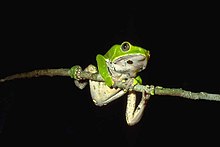Phyllomedusa bicolor, the giant leaf frog, bicolor tree-frog, giant monkey frog,[2] or waxy-monkey treefrog,[3] is a species of leaf frog. It can be found in the Amazon basin of Brazil, Colombia (Amazonas), Bolivia, and Peru, and can also be found in the Guianan Region of Venezuela and the Guianas, and in Cerrado of the state of Maranhão in Brazil.[4]
| Phyllomedusa bicolor | |
|---|---|

| |
| Scientific classification | |
| Domain: | Eukaryota |
| Kingdom: | Animalia |
| Phylum: | Chordata |
| Class: | Amphibia |
| Order: | Anura |
| Family: | Hylidae |
| Genus: | Phyllomedusa |
| Species: | P. bicolor
|
| Binomial name | |
| Phyllomedusa bicolor (Boddaert, 1772)
| |

| |
| Synonyms | |
| |
Description
editMales measure 91–103 mm (3.6–4.1 in) and females 111–119 mm (4.4–4.7 in) in snout–vent length. The dorsum is lime green whereas the belly is white to yellow-white or cream. Lower lips, chest and front legs bear sparse white spots with dark frames; these are more dense on the flanks and hind legs. Fingers are transparent brown and have large, green adhesive discs. There is a prominent gland extending from behind each eye over the tympanum. The iris is dark gray.[3]
Distribution and habitat
editIt is found throughout the Amazon Rainforest in Bolivia, the Guianas, Brazil, Colombia, Venezuela, and Peru. This frog has been found in gallery forest.[1]
Ecology and behaviour
editThe giant leaf frog is a nocturnal, arboreal frog. Males call from trees in tropical humid forests. Males fight each other for mating rights by using their heads to attempt to separate another male who is attached to a female. Males fend off rivals using a series of aggressive calls and use their hind legs to push away the rival.[4] During mating season, males may be targeted more by predators as the fights between males are very vocal and can be easily heard by predators. However, to combat this, giant leaf frogs produce peptides in their skin that serves as a chemical defence.[4] Giant leaf frogs reproduce like most frog species through amplexus, where the male climbs onto the female's back to fertilize the eggs.[4] The female and male construct a leaf-nest above forest pools, where the eggs are laid in a gelatinous mass of about 70 cm above the water. The eggs hatch from these nests in approximately 14 days, and the tadpoles fall into the water, where they continue the development into adult frogs. Peak reproduction occurs during the rainy season.[3][4] Eggs of the giant leaf frog are heavily predated and have a predation rate of up to 61%. Species that prey on the eggs include rove beetles, phorid flies, mammals – specifically capuchin monkeys– and other predators, such as snakes. The eggs are predated because they are source of protein for predators.[5]
Conservation
editThe IUCN endangered species database lists them in the "Least Concern" category, in view of their current wide distribution and large population.[1]
Medicinal use
editThe skin secretion of the giant leaf frog is known as Vacina do sapo (frog vaccine) and contains the opioid peptides deltorphin, deltorphin I, deltorphin II and dermorphin.[6][7][8][9] The secretion, known as Kambo or Sapo, has seen increasing popularity in cleansing rituals, where it induces intense vomiting.[10][11]
References
edit- ^ a b c IUCN SSC Amphibian Specialist Group (2023). "Blue-and-Yellow Frog: Phyllomedusa bicolor". IUCN Red List of Threatened Species. 2023. The IUCN Red List of Threatened Species: e.T55841A61405317. doi:10.2305/IUCN.UK.2023-1.RLTS.T55841A61405317.en. Retrieved January 28, 2024.
- ^ Frost, Darrel R. (2015). "Phyllomedusa bicolor (Boddaert, 1772)". Amphibian Species of the World: an Online Reference. Version 6.0. American Museum of Natural History. Retrieved 25 August 2015.
- ^ a b c "Phyllomedusa bicolor". AmphibiaWeb: Information on amphibian biology and conservation. [web application]. Berkeley, California: AmphibiaWeb. 2015. Retrieved 25 August 2015.
- ^ a b c d e Venâncio, Nathocley; Melo-Sampaio, Paulo (2010). "Reproductive behavior of the giant leaf frog Phyllomedusa bicolor (Anura: Hylidae) in the western Amazon". Phyllomedusa: Journal of Herpetology. 9 (1): 63–67. doi:10.11606/issn.2316-9079.v9i1p63-67.
- ^ Neckel-Oliveira, Selvino; Wachlevski, Milena (2004). "Predation on the Arboreal Eggs of Three Species of Phyllomedusa in Central Amazonia". Journal of Herpetology. 38 (2): 244–248. doi:10.1670/162-03A. S2CID 86277566.
- ^ Erspamer V, Melchiorri P, Falconieri-Erspamer G, et al. (July 1989). "Deltorphins: a family of naturally occurring peptides with high affinity and selectivity for delta opioid binding sites". Proceedings of the National Academy of Sciences of the United States of America. 86 (13): 5188–92. Bibcode:1989PNAS...86.5188E. doi:10.1073/pnas.86.13.5188. PMC 297583. PMID 2544892.
- ^ Lacombe C, Cifuentes-Diaz C, Dunia Iz Auber-Thomay M, Nicolas P, Amiche M (September 2000). "Peptide secretion in the cutaneous glands of South American tree frog Phyllomedusa bicolor: an ultrastructural study". European Journal of Cell Biology. 79 (9): 631–641. doi:10.1078/0171-9335-00085. PMID 11043404.
- ^ Melchiorri P, Negri L (1996). "The dermorphin peptide family". General Pharmacology: The Vascular System. 27 (7): 1099–107. doi:10.1016/0306-3623(95)02149-3. PMID 8981054.
- ^ Amiche M, Delfour A, Nicolas P (1998). "Opioid peptides from frog skin". Exs. 85: 57–71. doi:10.1007/978-3-0348-8837-0_4 (inactive 1 November 2024). ISBN 978-3-0348-9794-5. PMID 9949868.
{{cite journal}}: CS1 maint: DOI inactive as of November 2024 (link) - ^ Leban, V; Kozelk, G; Brvar, M (2016). "The syndrome of inappropriate antidiuretic hormone secretion after giant leaf frog (Phyllomedusa bicolor) venom exposure". Toxicon. 120: 107–109. Bibcode:2016Txcn..120..107L. doi:10.1016/j.toxicon.2016.07.007. PMID 27421671.
- ^ Daly, Max (May 10, 2016). "How Amazonian Tree Frog Poison Became the Latest Treatment for Addiction". Vice. Archived from the original on September 7, 2018. Retrieved October 31, 2018.
External links
editMedia related to Phyllomedusa bicolor at Wikimedia Commons
